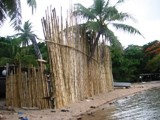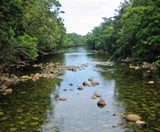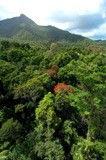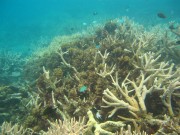Articles

As part of its commitment under Theme 5 of the MTSRF, the Reef and Rainforest Research Centre publishes, or makes available, outputs (e.g. final technical or scientific reports, synthesis reports) from MTSRF-funded research projects nested within Research Themes 1-4.
Researchers funded through the Australian Government’s Marine and Tropical Sciences Research Facility (MTSRF) have worked closely with Torres Strait communities to improve our understanding of both the vulnerability of Torres Strait islands to climate change, and their adaptation capacity.

As part of its commitment under Theme 5 of the MTSRF, the Reef and Rainforest Research Centre publishes, or makes available, outputs (e.g. final technical or scientific reports, synthesis reports) from MTSRF-funded research projects nested within Research Themes 1-4.
In response to the needs of managers of the Great Barrier Reef, a key focus area of the Australian Government's Marine and Tropical Sciences Research Facility (MTSRF) has been the development of thresholds of pollutants of concern in freshwater, estuarine and marine ecosystems. The outcomes of this research are summarised in this report, starting with an overview of new knowledge of the impacts of degraded water quality, and outlining how this work has been translated into threshold values and, ultimately in some cases, management guidelines for the GBR.

As part of its commitment under Theme 5 of the MTSRF, the Reef and Rainforest Research Centre publishes, or makes available, outputs (e.g. final technical or scientific reports, synthesis reports) from MTSRF-funded research projects nested within Research Themes 1-4.
The Great Barrier Reef (GBR) is a diverse ecosystem, which is bounded on its western side by a large number of large and small catchments. Protecting GBR ecosystems and the quality of the water they rely upon has become a major priority for resource managers and the community as a whole. Water quality and ecosystem health monitoring is needed to assess current status, identify existing and emerging problems, evaluate the consequences of various anthropogenic land and water use practices, devise improved practices and assess the effectiveness of management measures.

As part of its commitment under Theme 5 of the MTSRF, the Reef and Rainforest Research Centre publishes, or makes available, outputs (e.g. final technical or scientific reports, synthesis reports) from MTSRF-funded research projects nested within Research Themes 1-4.
In the Wet Tropics of Queensland, tropical rainforest covered an estimated 965,000 ha prior to European settlement of the area during the 19th and 20th centuries. Subsequent human impacts resulted in a reduction in the area of rainforest to approximately 750,000 ha.
Here, Tng and others explore the rates of landscape change and landscape conditions associated with rainforest expansion in the Wet Tropics World Heritage region of northeastern Queensland. They assess change in rainforest in a 270 square kilometre study area within the Wet Tropics Bioregion, and ask to what extent rates of rainforest change were similar for particular time periods and mediated by climatic and landscape conditions.
Most marine invasive species have been introduced to Australian waters unintentionally through shipping activities and mariculture.

Dugongs (Dugong dugon) are marine mammals, which are commonly known as sea cows. Australia is home to most of the world’s dugongs. They live in northern waters between Shark Bay in Western Australia and Moreton Bay in Queensland. One of the reasons for nominating the Great Barrier Reef as a World Heritage Area in 1981 was its importance as a feeding ground for large populations of dugongs.
Tropical northern Australian waters are home to a number of harmful jellyfish, including the large multi-tentacled deadly box jellyfish Chironex fleckeri and several species of smaller jellyfish known to cause the debilitating Irukandji syndrome.
Coral reef fish are caught by hook and line along the length of the Great Barrier Reef from the Torres Strait south to Fraser Island. More than 120 fish species are caught in the commercial line fishery, although only a few of them are actively targeted by commercial fishers. The high-value target species include coral trout, red throat emperor, red emperor, tropical snapper and Spanish mackerel.
Recreational anglers also target these species, particularly highly prized trophy species such as Spanish mackerel, red emperor and coral trout.
Research on the biology of fish species and the impacts of fishing is helping managers balance the needs of users while maintaining reef fish stocks and the reef ecosystem for future generations.
Biology is the study of all living organisms (plants, animals, microorganisms) and how they interact with each other and their environment. It examines the structure, classification, function, growth, origin, evolution, and distribution of all living things.
Zooxanthellae are unicellular, golden-brown algae (dinoflagellates) that live either in the water column as plankton or symbiotically inside the tissue of other organisms. The most common symbiotic association is with hard, reef-building (or hermatypic) corals, although zooxanthellae can also be found living inside the tissue of soft corals, jellyfish, giant clams and nudibranchs.

Macroalgal species are divided among three large groups that are named according to the colour of their dominant photosynthetic and accessory pigments: red (Rhodophyta), green (Chlorophyta) and brown (Phaephyta).



